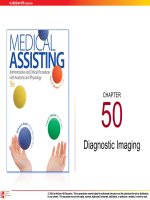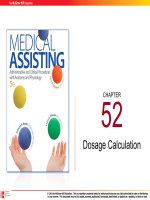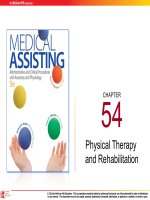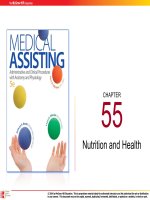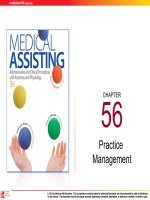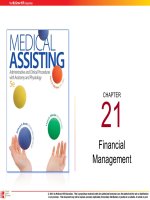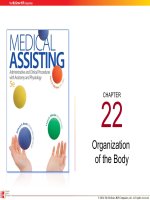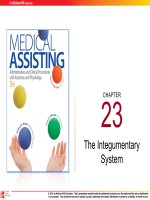Medical assisting Administrative and clinical procedures (5e) Chapter 13 Telephone techniques
Bạn đang xem bản rút gọn của tài liệu. Xem và tải ngay bản đầy đủ của tài liệu tại đây (1.01 MB, 53 trang )
CHAPTER
13
Telephone
Techniques
13-2
Learning Outcomes (cont.)
13.1
Explain the purpose of the telecommunications
equipment commonly found in the medical office.
13.2
Relate the five Cs of effective communication to
telephone communication skills.
13.3. Define the following terms involved in making a good
impression on the telephone: telephone etiquette,
pitch, pronunciation, enunciation, and tone
13-3
Learning Outcomes (cont.)
13.4 Describe how to appropriately handle the
different types of calls coming into the medical practice.
13.5
Summarize the purpose of the office routing list in
regards to call screening.
13.6 Carry out the procedure for taking a complete
telephone message.
13.7
Outline the preparation required prior to making
outgoing calls and the skills used in making the
phone call.
13-4
Introduction
• Telecommunications
– Telephone
• Etiquette
• Routing calls
• Triaging calls
• Messages
– Other communication devices
13-5
Telecommunications Equipment
• Telephone system
• Multi-line telephones
• Automated voice response unit
– Answer calls
– Make reminder calls
– Patient surveys
13-6
Telecommunications Equipment (cont.)
• Voicemail
• Answering machine
• Answering service
Cell Phones – Personal and Business
Use
• Personal use
– Be considerate of others
– Office policy
• Business use
13-7
13-8
Pagers (Beepers)
• Technology
• Calling a pager
• Interactive pagers
– Two-way communication
– Traditional page capabilities also
13-9
Patient courtesy phone
• Block long distance
• Keeps business lines free
• Limit time
13-10
Telecommunication Devices for the Deaf
• Specially designed telephone
• Message is typed and relayed to
– Another TDD
– Telecommunications
relay service (TRS)
13-11
Apply Your Knowledge
A personal emergency call has been received for
the physician, who is currently not in the office.
Which device or service would the medical
assistant use to contact the physician?
ANSWER: The medical assistant may call the physician on
his cell phone or use a pager or interactive pager to contact
a physician who is out of the office.
Hello! Right
Answer!!!!
13-12
Effective Telephone Communication
• Present a positive
image
• Convey a caring,
attentive and helpful
image
• Professional and
knowledgeable
13-13
Communication Skills
• Using tact and sensitivity
• Showing empathy
• Giving respect
• Being genuine
• Being open and friendly
• Not passing judgment or stereotyping other
13-14
Communication Skills (cont.)
• Being supportive
• Asking for clarification and feedback
• Paraphrasing to ensure understanding
• Being receptive to the patient’s needs
• Knowing when to speak and when to listen
• Considers other viewpoints
13-15
Communication Skills (cont.)
Guidelines for Using the Telephone
Effectively
• Answer promptly
• Hold the mouthpiece about an inch away from
your mouth
• Leave one hand free to write with
• Give the practice name and your name
• Acknowledge the caller, be willing to assist
13-16
Guidelines for Using the Telephone
Effectively
• Always be courteous, calm, and pleasant
• Identify the nature of the call, devote full
attention to the caller
• Allow caller to hang up first; say goodbye and
use the caller’s name
• Comply with HIPAA guidelines
13-17
13-18
Apply Your Knowledge
What should effective telephone communication
convey?
ANSWER: It should convey :
A positive, professional image of the medical practice
That the staff is caring, attentive, and helpful
That the staff is knowledgeable
13-19
Telephone Etiquette
• Your telephone voice
– Speak directly into the receiver
– Smile
– Visualize the caller
– Be friendly, respectful,
helpful, and alert
13-20
Telephone Etiquette
• Your telephone voice
– Use non-technical
language
– Use a normal tone, but attempt to vary your
pitch
– Make the caller feel important
13-21
Your Telephone Voice
Tone
Pronunciation
Saying words correctly
Positive and respectful
Enunciation
Clear and distinct speaking
13-22
Making a Good Impression
• Exhibiting courtesy
• Giving undivided attention
• Putting a call on hold
– Ask the purpose
– Ask permission
– Offer to call back
– Return to caller frequently
13-23
Making a Good Impression (cont.)
• Returning calls
• Remembering patient names
• Checking for understanding
13-24
Making a Good Impression (cont.)
• Communicating feelings – empathy
• Ending the conversation
– Summarize important points
– Thank the caller for calling
– Allow the caller to hang up first
13-25
Apply Your Knowledge
The medical assistant is just returning from lunch, and the office
telephone is ringing. When the medical assistant answers, the
caller interrupts her greeting and says, “No, do not put me on
hold again, I have been on hold for 10 minutes!” How should
the medical assistant respond to this caller?
ANSWER: The medical assistant should remain calm, allow the
caller to express his or her concerns, apologize for any
inconvenience, and inform the caller that you would like to help.
The MA should not attempt to shift the blame by telling the caller
that he or she was just returning from lunch and instead should
put effort into assisting the caller.
